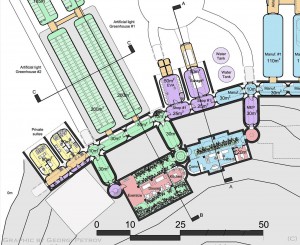
By Svetlana Shkolyar
What do the rocket scientist Dr. Wernher von Braun, 1950s television programs and magazine articles, and an emerging corporation focused on the human settlement of Mars have in common? They all recognize that linking science and the media creates excitement and support. Their objective has been to inspire the rest of us that “Man Will Conquer Space Soon!” In the 1950s, this sentiment was conveyed by von Braun in a series of influential magazine articles. The 4Frontiers Corporation is making similar efforts today.
Capturing America’s Imagination
German-born von Braun developed the V-2 missile during World War II, but his real interest was in engineering rockets for space exploration, not war. Throughout his American career, during which he guided the development of the Saturn V launch vehicle and directed NASA’s Marshall Space Flight Center, von Braun worked tirelessly to convince the public that mankind should escape from what he called the “chains of gravity” that bind us to the earth. In the 1950s, Collier’s Weekly, which had a circulation of more than four million, asked von Braun to contribute articles about his vision for space exploration. Those articles included his concepts for a space station and spurred the movement to create one.
As space historian Randy Liebermann notes, “After twenty-five years of continuous and directed thinking and endless hours of experimentation, von Braun, the world’s leading rocket engineer, had the chance to come out of his sequestered military environment and, through a national magazine, inform the general public of his detailed blueprint for realizing manned space travel.”
Von Braun was considered to be the “father of the U.S. space program” not only for his pioneering rocket science, but also for the way he promoted the space program, especially through his work with Walt Disney. He worked as a technical director with Disney to create three space-related television films. Disney introduced “Man in Space” and “Man and the Moon” in 1955 and “Mars and Beyond” in 1957, seen by an estimated forty-two million viewers. Von Braun’s objective was to create what he called a “science factual” show.
Together, von Braun and Disney used the power of the new medium of television to convey to Americans just “how high man might fly on the strength of technology and the spirit of human imagination,” in the words of Marshall Space Flight Center historian Mike Wright.
These Disney films were the first to explain basic science in a vivid, humorous, and colorful way. “It was a matter of synthesizing the philosophical aspects into neat packages and solid statements which the public would buy,” wrote Erik Bergaust, von Braun’s biographer. Critics and commentators regarded the shows not as science fiction entertainment but rather as predictions of what emerging technology would make possible. Dr. Ernst Stuhlinger, a technical consultant for the shows, wrote that von Braun’s wish to see man conquer space meant turning not just scientists, industry, and politicians into supporters but also, most importantly, the public.
Applying Von Braun’s and Disney’s Techniques Today
Like von Braun in the 1950s, the 4Frontiers Corporation understands that although technical skills are essential, it takes public support as well as strengths in many other areas to “conquer” the ultimate frontier. Applying this understanding is key to their strategy.
In July 2005, 4Frontiers was founded at the Massachusetts Institute of Technology to help extend humanity’s reach to new frontiers, specifically the first human settlement on Mars. The four frontiers the founders envision are Earth orbit, the moon, Mars, and asteroids. While humans may not conquer Mars for at least another decade, informative entertainment, Earth-based technology development, and consultancy are three business frontiers the company is working to master today. Efforts in these areas will lay the foundation needed to pursue their ultimate objective.
A crucial aspect of 4Frontiers’ strategy is to engage the public through informative entertainment, sharing its vision and its latest innovations while translating public interest into support of the company’s research and business operations. To do so, the company has been developing a number of unique ventures. Educational tour packages have been created for groups interested in space and U.S. culture, providing behind-the-scenes tours of space and science centers throughout the country. 4Frontiers is even planning a television reality show where groups of individuals compete as if they were early Mars settlers. New media such as Twitter and Facebook are being used to engage the public in 4Frontiers’ efforts.
A second avenue being pursued is educational programming. 4Frontiers knows that educating and exciting today’s youth will help to inspire tomorrow’s pioneers. Fictional stories about the first family on Mars have been included in an interactive children’s Web site, www.crazy4mars.com. Curricula have been developed for fifth-through seventh-grade classrooms that present the theme of Mars exploration. The company is also planning to open an Informative Entertainment Center that will house a museum, business center, and research facility for innovative space technologies.

Close-up view of 4Frontiers’ site of the first permanent settlement on Mars.
Image courtesy 4Frontiers Corporation
4Frontiers recognizes that the pursuit of interesting technology alone is insufficient to permit the company to accomplish its goals. As Peter Collins, an intern for 4Frontiers, explains, “It is not just technical skills that will get us to Mars, but business skills also; projects need to be managed, funding obtained, and profits made along the way.”
The third business segment that the corporation is exploring is consultancy. “The company is developing a solid client base for its space technology engineering consulting. Real value can be added in this area through cross-pollination between different technical disciplines,” said Joseph Palaia, vice president and cofounder of 4Frontiers.
The company has provided consulting services for some organizations, including one researching advanced energy conversion technology in Florida and another manufacturing semiconductor equipment in Massachusetts. “Technical solutions we develop for the space frontier often have direct applicability here on Earth,” said Palaia. The company has also consulted for Galactic Suite Limited, a company aiming to get an orbiting space vacation resort open in 2012. 4Frontiers even provided entertainment and education consulting services for high school students from New Delhi, India, including the development and execution of two custom tour package programs for them.
The Power of Diversity
The co-founders of 4Frontiers, CEO Mark Homnick and Vice President Palaia, both have engineering backgrounds. They have played leading roles in the company’s Mars settlement design efforts, and they are strong proponents of bringing people with diverse skills together to develop inventive solutions to problems and rich visions of the future.
“Imagine if you were tasked with designing a city on another planet,” Palaia said. “We cannot do that unless we are multidisciplinary.” Indeed, the company has engaged some untraditional participants, including specialists in astrosociology, psychology, artistic rendering, and science fiction writing, alongside the more traditional technical disciplines. What enables communication between these individuals who would not normally interact is their interest and passion for 4Frontiers’ mission. Through their brainstorming, whether face to face or via communication technologies, they can come up with ideas to solve technical problems relevant to Mars and here on Earth.
An example of this approach occurred during the Generation II Mars settlement programming study meeting in Atlanta in 2006. In one weekend, more than two dozen experts gathered to refine concepts for the first Mars settlement. No two members were from the same discipline. Those in attendance included, among many others, experts in aerospace engineering, medical factors, psychology, and architecture. The Generation II study helped 4Frontiers facilitate later investigations on settlement architecture and greenhouse material.
According to Palaia, progress in the coming decades will be driven by work from teams who cross the boundaries between disciplines. These diverse groups may discover new approaches to problems that have typically been handled exclusively by one discipline. 4Frontiers will engage partner organizations and individuals to execute project elements and move the work forward. The drawback to this multidisciplinary approach from a corporate perspective is closely related to what makes them successful: these teams tend to come up with very ambitious new ideas. “We are good at developing innovative crossdiscipline solutions,” said Palaia, “but then we need to engage teams outside our group to actively develop those ideas.”
Within 4Frontiers, people use their own varied skills to work effectively. Homnick leveraged his engineering background and managerial skills to manage the Generation I Mars settlement programming study, which now serves as a foundational element of the company’s Mars settlement research efforts. His expertise in project management for large-scale electronics projects was useful to the settlement study because elements of risk and incomplete information are common in both. He was able to use a wellunderstood project management process, apply it to this study about a topic that is not well understood, and achieve a meaningful result. Homnick led the study effort to identify the goals, objectives, and project needs, just as in a typical project management situation, to determine that a project like this was feasible.
The company looks continually for new ideas. Interns Alex Stimpson and John Truett, exploring various research grant opportunities during the summer of 2008, proposed using nanotubes to increase the permeability of fish eggs and embryos, enabling their cryopreservation. A research proposal is being developed to actively pursue this innovation.
New Frontiers
The very first press release put out by 4Frontiers explained why it is one of the few start-ups treading the ground of these new frontiers: “While a number of companies have set their sights on advancements in getting to Mars, few have laid out plans with technical reality and actual designs to quickly and affordably establish settlement.”
“Lots of people tried just the technical approach. We don’t think that’ll work. It is too myopic,” explained Homnick. “Others try education and tourism and don’t develop technology. That’s short-lived, too. We combined the two; that’s how we created 4Frontiers—a symbiotic relationship between the elements.”
The company is in the early stages of designing and building an Informative Entertainment Center, where visitors will be able to tour a full-scale Mars settlement replica. There, they can sample Mars algae snacks, buy tickets for space vacations and experiences from real space tourism companies like Virgin Galactic, and see technologies and systems being engineered for future use on Mars.
One final motivation inspires 4Frontiers. According to Palaia, “Human beings benefit from going into new environments. Here on Earth, we’ve run out of physical frontiers.” Von Braun might have agreed.
About the Author
 |
Svetlana Shkoylar is a science communication graduate student, researcher, and writer. |










